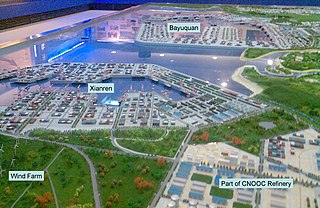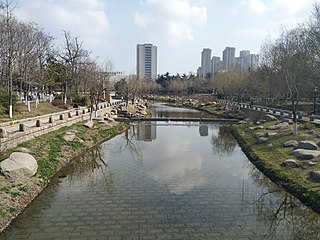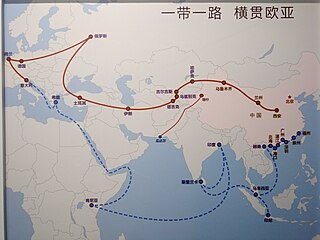External links
- Qingdao Port (Group) Ltd. website (in Chinese)
36°05′00″N120°19′01″E / 36.0833°N 120.317°E / 36.0833; 120.317
| | This article related to ports, harbors or marinas is a stub. You can help Wikipedia by expanding it. |
The Port of Qingdao is a seaport on the Yellow Sea in the vicinity of Qingdao (Tsingtao), Shandong Province, People's Republic of China. It is one of the ten busiest ports in the world (7th in 2019, considering total cargo volume). [1]
Qingdao Port consists of four areas, which are often themselves referred to as ports due to their size: Dagang port area, Qianwan port area, Huangdong oil port area (for oil tankers), and Dongjiakou (Chinese :董家口) port area, the latter being located 40 kilometres south of Qingdao city. [2]
Including the Qingdao Qianwan Container Terminal and the Qingdao Cosport International Container Terminal, which are located in different areas, Qingdao also has a large terminal for handling iron ore. [3]
In 2011, the Qingdao Port, together with three other Chinese ports in East China's Shandong Province, signed a strategic alliance with the largest port of the Republic of Korea (ROK). The alliance included Shandong's Qingdao Port, Port of Yantai, Port of Rizhao, Port of Weihai, and the ROK's Port of Busan and aimed to build a shipping and logistics center in Northeast Asia. [4]
In May, 2014, Qingdao Port International Co. Ltd. announced it was seeking to raise up to US$377 million in a Hong Kong initial public offering.
In August 2014, it was revealed that the firm was involved in two lawsuits with the global warehousing firm Pacorini Logistics, claiming a total of $58.4 million in damages. This followed a lawsuit the firm had already been subject to from CITIC Resources. [5]
The port is part of the 21st Century Maritime Silk Road that runs from the Chinese coast to Singapore, towards the southern tip of India to Mombasa; from there through the Red Sea via the Suez Canal and to the Mediterranean; and from there to the Upper Adriatic region to the northern Italian hub of Trieste with connections to Central Europe and the North Sea. [6] [7] [8] [9] [10]
A world's first suspended monorail capable of carrying fully loaded 20' and 40' containers has been under construction since 2020 at the Port of Qingdao, the first phase of which was put into operation in 2021. [11] [12]

The Port of Singapore is the collection of facilities and terminals that conduct maritime trade and handle Singapore's harbours and shipping. It has been ranked as the top maritime capital of the world, since 2015. Currently the world's second-busiest port in terms of total shipping tonnage, it also transships a fifth of the world's shipping containers, half of the world's annual supply of crude oil, and is the world's busiest transshipment port. It was also the busiest port in terms of total cargo tonnage handled until 2010, when it was surpassed by the Port of Shanghai.

The Port of Hong Kong located by the South China Sea, is a deepwater seaport dominated by trade in containerised manufactured products, and to a lesser extent raw materials and passengers. A key factor in the economic development of Hong Kong, the natural shelter and deep waters of Victoria Harbour provide ideal conditions for berthing and the handling of all types of vessels. It is one of the busiest ports in the world, in the three categories of shipping movements, cargo handled and passengers carried. This makes Hong Kong a Large-Port Metropolis.

Rizhao, alternatively romanized as Jihchao, is a prefecture-level city in southeastern Shandong province, China. It is situated on the coastline along the Yellow Sea, and features a major seaport, the Port of Rizhao. It borders Qingdao to the northeast, Weifang to the north, Linyi to the west and southwest, and faces Korea and Japan across the Yellow Sea to the east.

DP World is an Emirati multinational logistics company based in Dubai, United Arab Emirates. It specialises in cargo logistics, port terminal operations, maritime services and free trade zones. Formed in 2005 by the merger of Dubai Ports Authority and Dubai Ports International, DP World handles 70 million containers that are brought in by around 70,000 vessels annually. This equates to roughly 10% of global container traffic accounted for by their 82 marine and inland terminals present in over 40 countries. Until 2016, DP World was primarily a global port operator, and since then, it has acquired other companies up and down the value chain.

Kwai Tsing Container Terminals is the main port facilities in the reclamation along Rambler Channel between Kwai Chung and Tsing Yi Island, Hong Kong. It evolved from four berths of Kwai Chung Container Port completed in the 1970s. It later expanded with two berths in the 1980s. Two additional terminals are added adjoining to Stonecutters Island in the 1990s and was renamed Kwai Chung Container Terminals. In the 2000s, Container Terminal 9 on the Tsing Yi Island was completed and the entire facility was renamed to Kwai Tsing Container Terminals.

The Port of Rotterdam is the largest seaport in Europe, and the world's largest seaport outside of East Asia, located in and near the city of Rotterdam, in the province of South Holland in the Netherlands. From 1962 until 2004, it was the world's busiest port by annual cargo tonnage. It was overtaken first in 2004 by the port of Singapore, and since then by Shanghai and other very large Chinese seaports. In 2020, Rotterdam was the world's tenth-largest container port in terms of twenty-foot equivalent units (TEU) handled. In 2017, Rotterdam was also the world's tenth-largest cargo port in terms of annual cargo tonnage.

The Port of Shanghai, located in the vicinity of Shanghai, comprises a deep-sea port and a river port.

China Merchants Port Holdings Company Limited is a major conglomerate based in Hong Kong and is involved in a range of businesses such as port operations, general and bulk cargo transportation, container and shipping business, air cargo, logistics park operations and paint products. China Merchants Port is considered as a Red Chip company as the Hong Kong Stock Exchange listing. The company has port facilities in mainland China and Hong Kong, and the predecessor was founded in 1991. The predecessor of the parent company was established in 1872 and was the preeminent industrial and commercial group in mainland China. Before changing its name to China Merchants Port Holdings Company Limited, the company was formerly known as China Merchants Holdings (International) Company Limited.
Port of Guangzhou is the main seaport of Guangzhou city, Guangdong province, China. The port is operated by Guangzhou Port Group Co. Ltd which is a state owned company. The company was established on February 26, 2004 from the former Guangzhou Harbor Bureau. It was approved by the Guangzhou Municipal Government. It is currently the largest comprehensive port in South China. Its international maritime trade reaches over 300 ports in more than 80 countries and districts worldwide. The port also incorporates the former Huangpu Port.

The Port of Ningbo-Zhoushan is the busiest port in the world in terms of cargo tonnage. It handled 888.96 million tons of cargo in 2015. The port is located in Ningbo and Zhoushan, on the coast of the East China Sea, in Zhejiang province on the southeast end of Hangzhou Bay, across which it faces the municipality of Shanghai.

The Port of Yingkou is an international seaport in Yingkou, Liaoning, People's Republic of China. It is the second-largest port in northeast China and the tenth-largest nationwide. It includes two separate dockland areas, the Yingkou old port at the mouth of the Daliao River, and the Bayuquan port located directly on Liaodong Bay on the Bohai Sea.
The Port of Weihai is a seaport on the Yellow Sea in the vicinity of Weihai, Shandong, People's Republic of China.

In 1961 China established a state-run maritime shipping company and subsequently signed shipping agreements with many countries, laying the foundation for developing the country's ocean transport. That organization developed into the present-day China Ocean Shipping (Group) Company (COSCO). The Chinese government also invested heavily in water transport infrastructure, constructing new ports and rebuilding and enlarging older facilities.

Shibei District is an urban district of Qingdao, Shandong Province, People's Republic of China. As of 2010, it has an area of 63.18 square kilometres (24.39 sq mi) and around 1,027,000 inhabitants. In December 2012, the neighbouring Sifang District was merged into Shibei.
Qingdao Qianwan Container Terminal is a port of China, located at Qianwan, Qingdao, Shandong province. Qingdao Port ranked 10th in 2008 world's busiest container ports with 10,320 thousands TEU, current projects were expected to raise the capacity to 15,000 thousands or more.

Port of Baku is a sea port located in the Bay of Baku, on the coast of city of Baku, Azerbaijan. The main entrance faces the Neftchiler Avenue.
Shandong Hi-Speed Group Corporation or Shandong Gaosu Group, (SDHS), is a solely state-owned enterprise in Jinan, China, owned by the Shandong Provincial People's Government. It is mainly engaged in investment, construction and operation of highways, expressways, bridges, railways, rail transits, harbours, shipping and logistics. It also sets foot in construction, building material, information, financing, real estate and other sectors related to its main business. In June 2011, SDHS opened the Jiaozhou Bay Bridge spanning more than 40 kilometers between Qingdao and Huangdao District in Shandong, making it the longest cross-sea bridge in the world.

Valemax ships are a fleet of very large ore carriers (VLOC) owned or chartered by the Brazilian mining company Vale S.A. to carry iron ore from Brazil to European and Asian ports. With a capacity ranging from 380,000 to 400,000 tons deadweight, the vessels meet the Chinamax standard of ship measurements for limits on draft and beam. Valemax ships are the largest bulk carriers ever constructed, when measuring deadweight tonnage or length overall, and are amongst the longest ships of any type currently in service.

The 21st Century Maritime Silk Road, commonly just Maritime Silk Road (MSR), is the sea route part of the Belt and Road Initiative which is a Chinese strategic initiative to increase investment and foster collaboration across the historic Silk Road.